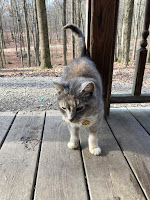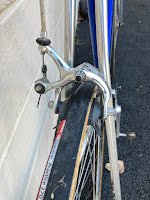If anyone had ever told me 20 years ago that I would end up living with and loving three adorable cats, I would never have believed them.
But here I am, with three little fur buddies, and I love them all, and wouldn't part with them.
How the heck did this happen?
Well, before I get to that, why would it have seemed so unlikely to me 20 years ago?
First and foremost, while my family had two different dogs when I was a kid (a Beagle and a Brittany many years apart), we never had cats, and I honestly can't remember any friends who had cats either. So, they were pretty much an unknown to me until my teen years, when my older sister Nancy had a couple of cats. I spent a lot of time at her house, because her then-husband Phil and I had launched a kite making company, and I would go over and work on kites with him whenever I could.
The good news here is that I got to spend some time with her two cats. The bad news is, that even by my sister's recollection, one of them was, well, let's politely say "unpredictable." My most vivid memory of Maggie was the day she was calmly perched on a table in the kite workroom, and I was petting her and she happily enjoyed it... for a time. Suddenly, for no apparent reason, she erupted and I found myself with an angry ball of fur running up one arm, over my head, and down the other side of me, claws fully extending and uttering sounds of fury. I didn't realize it at the time, but apparently my sister's German Shepherd had just appeared, and Maggie hadn't met him and freaked out. To me, it seemed utterly unprovoked, and I never realized the dog was part of it until just a few years ago.
So, for many, many years, I was at best indifferent to cats, and certainly never imagined having any in my home. Now and then I'd encounter one, but never one that in any way changed my thinking about cats. Until my brother moved back from California just before my last year of college, and I got to know his little Manx, Savannah. At first, we didn't really have much to do with each other, but at one point, I don't recall exactly why, I ended up taking care of her while Stephen was away for a week or so. During that time, she became much friendlier toward me (the cynic in me said it was because I was the can opener), and even started to sleep in my bed at night. The biggest downside to that was that she seemed fond of sleeping on my head, which isn't really something I'd recommend. Anyway, I credit Savannah with the first chink in my anti-cat armor.
 |
Savannah, around 1983, on my desk.
|
Fast forward to the early 2000s, when I started dating a woman with a cat named Tomas. Now, I don't think even his human would claim Tomas was the rocket scientist of the cat world, but he couldn't have been a sweeter little guy. Again, I was called upon for cat care a few times, and he and I gradually became pals. Once Annie and I decided to move in together, we started discussing finding a sidekick for Tomas. This lead to finding the wonderful Tybalt in a shelter, who from the start was meant to be my cat. That little fellow really opened my eyes and my heart to cats, and gave me 16 wonderful years before he died in 2021. (You can read more about him here.)
 |
Tybalt in 2020, at the age of 15 or so.
|
Now, that explains how I came to have A cat, but not three. When Tybalt was middle aged, I was busy transitioning to owning a bicycle shop, and also spending a lot of time over in Maryland with a woman I was seeing at the time. At some point, with Christy's urging, I started thinking about a buddy for Tybalt. On a visit to a shelter, seeking parakeets (for Christy), we met a little tabby that had just been captured that Christmas Eve, and had been named Tiny Tim as a result. When let out of his cage to meet us, he strutted around like he owned the place. He quickly won my heart, and after a prolonged delay and drama due to his contracting a respiratory infection in the shelter, he was renamed Jinx and finally came home to join Tybalt in my apartment.
 |
Jinx at 4, in his classic Krazy Kitty Mode, 2017.
|
 |
Jinx at 5, in a more mellow moment, 2018.
|
The two of them seemed to get along fine, though Jinx was a bit more boisterous than Tybalt liked sometimes, and in particular he seemed to like harassing Tybalt at the litter box, which lead to some issues for a while. Still, over time they seemed to co-exist very well, and while they didn't sleep together or play a lot, they would groom each other and hang out nearby.
I only learned just how attached they'd apparently grown when Tybalt died in 2021, and Jinx suddenly developed a "barbering" (over-grooming) habit. I missed Tybalt tremendously, but Jinx was always there for a cuddle, and he and I grew closer. By a coincidence, one of my employees at the bike shop had a young black cat that wasn't fitting in well with their older cat, so it was suggested I take Zero on as a pal for Jinx. So, as of autumn of 2021, Jinx and Zero had really hit it off and I'd settled back into a two cat household.
 |
Zero in an improvised cat bed on my desk, 2022.
|
And then I took my annual trip to a cabin at a state park in Pennsylvania, just after Thanksgiving, 2022. If you follow this blog, you'll know what happened next, as that was the one post I shared in early 2023. Yep, I found a cat at the cabin, and not for the first time either. The first time it was a sweet girl cat with a collar and tags that I reunited with her humans after a six month separation. The second, in 2022, well, he had no tags, no chip, no known humans or backstory, so he came home with me. I named him Chester Proudpaw, making my little family a feline trio.
 |
Chester in December 2023, a year after he came home with me.
|
So now, with three cats in a one bedroom apartment, I think I am officially a "cat person", something I never would have imagined years ago. And something I wouldn't trade for the world. Each of my cats has been a truly unique personality, something I wouldn't have guessed from my early experiences with cats.
Tybalt was utterly attached and devoted to me, happily curling up in my lap or next to me at every opportunity and rarely letting me out of sight if I was home. But he was very shy and skittish around strangers, and took a long time to warm up to people. When I had to be out of town and someone else took care of him, more often than not, they'd get barely a glimpse of him at best, and often the only evidence he was around was that the food would be eaten and the litter box used.
Jinx was a lot more independent, especially when young, and lap time with him always felt a bit like a "drive by" situation. That being said, from the very start, that guy has always given the best cat hugs, where he'll wrap his front paws around my neck and just hold on. As he's gotten older, and especially after Tybs died, he's settled down a lot and is much more inclined to linger with me. And while his "barbering" appears to be a thing of the past, he still enjoys grooming me, licking my beard and rubbing his face all over it, as well as grooming the other cats.
Zero is still pretty young, around four now I guess so he's still a bit more in the "drive by" mode affection-wise. But with time, he's definitely come around to me being his human and the other guys as his pack, and he loves having other cats to wrestle and chase around and play with. He's also one of the best and enthusiastic "biscuit makers" of any cat I've met. The intensity with which he stares at me while kneading me is pretty entertaining.
And then there's Chester. He reminds me a LOT of Tybalt, in markings, size and personality. Thanks to the nights in the cabin, and bringing him to safety, he's quite bonded to me. There were also a couple of weeks where I spent nights sleeping in my bike shop with him, while waiting for him to be checked out and then neutered by the vet before bringing him home to meet the others. The big difference between him and Tybalt though is that Chester is not really shy or skittish around others, and generally loves attention. He now comes to the shop with me often, when we are in the slower season and we keep all the doors closed except for customers and bikes going in and out. He doesn't show any signs of interest in getting out, but we are all very attentive when ever he's in the shop to prevent any mishaps. He's also become a bit of a local celebrity, named "Mayor's Pet of the Month" in the town newsletter last spring, and featured in a community service award the shop received last year.
 |
Bikes@Vienna's 2023 Carole Wolfand Community Service award, featuring Chester.
|
So, here I am in my early 60s, with three cats, and loving it.
 |
Chester, Zero, and Jinx, aka the Gang of Three, January 2024.
|





























